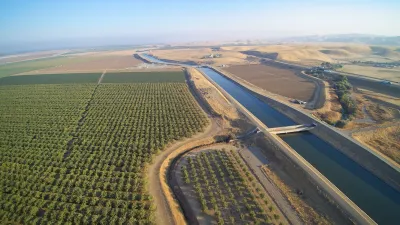In one of the most remarkable spurts of renewable energy investment in the U.S., six solar plants have been approved in six weeks in the California desert totaling almost 3 gigawatts. More are on the way, including new Stirling dish technology.
The developers are also encouraged by the adoption of a new regulation to have 33% of the state's energy come from renewable sources by 2020 and a new law that requires utilities "to bank a portion of the electricity they generate."
"Regulators and developers are racing to put shovels to ground before the end of the year when federal incentives for large renewable energy projects will expire. The loss of federal incentives could threaten the financial viability of some of the solar projects.
Since Aug. 25, the energy commission has licensed six solar thermal power plants that would cover some 39 square miles of desert land and generate 2,829 megawatts. That's nearly six times as much solar capacity as was installed in the United States last year, mostly from rooftop solar panels.
Tessera Solar's Imperial Valley project, on the other hand, will be the first big test of Stirling dish technology. Resembling a giant mirrored satellite receiver, the 38-foot-high, 40-foot-wide solar dish focuses the sun's rays on a Stirling engine, heating hydrogen gas to drive pistons that generate 25 kilowatts of electricity. Some 29,000 of Tessera's Suncatchers will be installed on more that 6,400 acres of desert land near the Mexican border about 100 miles east of San Diego." [See photos].
FULL STORY: California big solar binge continues with approval of more projects

Study: Maui’s Plan to Convert Vacation Rentals to Long-Term Housing Could Cause Nearly $1 Billion Economic Loss
The plan would reduce visitor accommodation by 25,% resulting in 1,900 jobs lost.

North Texas Transit Leaders Tout Benefits of TOD for Growing Region
At a summit focused on transit-oriented development, policymakers discussed how North Texas’ expanded light rail system can serve as a tool for economic growth.

Why Should We Subsidize Public Transportation?
Many public transit agencies face financial stress due to rising costs, declining fare revenue, and declining subsidies. Transit advocates must provide a strong business case for increasing public transit funding.

How Community Science Connects People, Parks, and Biodiversity
Community science engages people of all backgrounds in documenting local biodiversity, strengthening connections to nature, and contributing to global efforts like the City Nature Challenge to build a more inclusive and resilient future.

Alabama: Trump Terminates Settlements for Black Communities Harmed By Raw Sewage
Trump deemed the landmark civil rights agreement “illegal DEI and environmental justice policy.”

Dear Tesla Driver: “It’s not You, It’s Him.”
Amidst a booming bumper sticker industry, one writer offers solace to those asking, “Does this car make me look fascist?”
Urban Design for Planners 1: Software Tools
This six-course series explores essential urban design concepts using open source software and equips planners with the tools they need to participate fully in the urban design process.
Planning for Universal Design
Learn the tools for implementing Universal Design in planning regulations.
City of Santa Clarita
Ascent Environmental
Institute for Housing and Urban Development Studies (IHS)
City of Grandview
Harvard GSD Executive Education
Toledo-Lucas County Plan Commissions
Salt Lake City
NYU Wagner Graduate School of Public Service





























